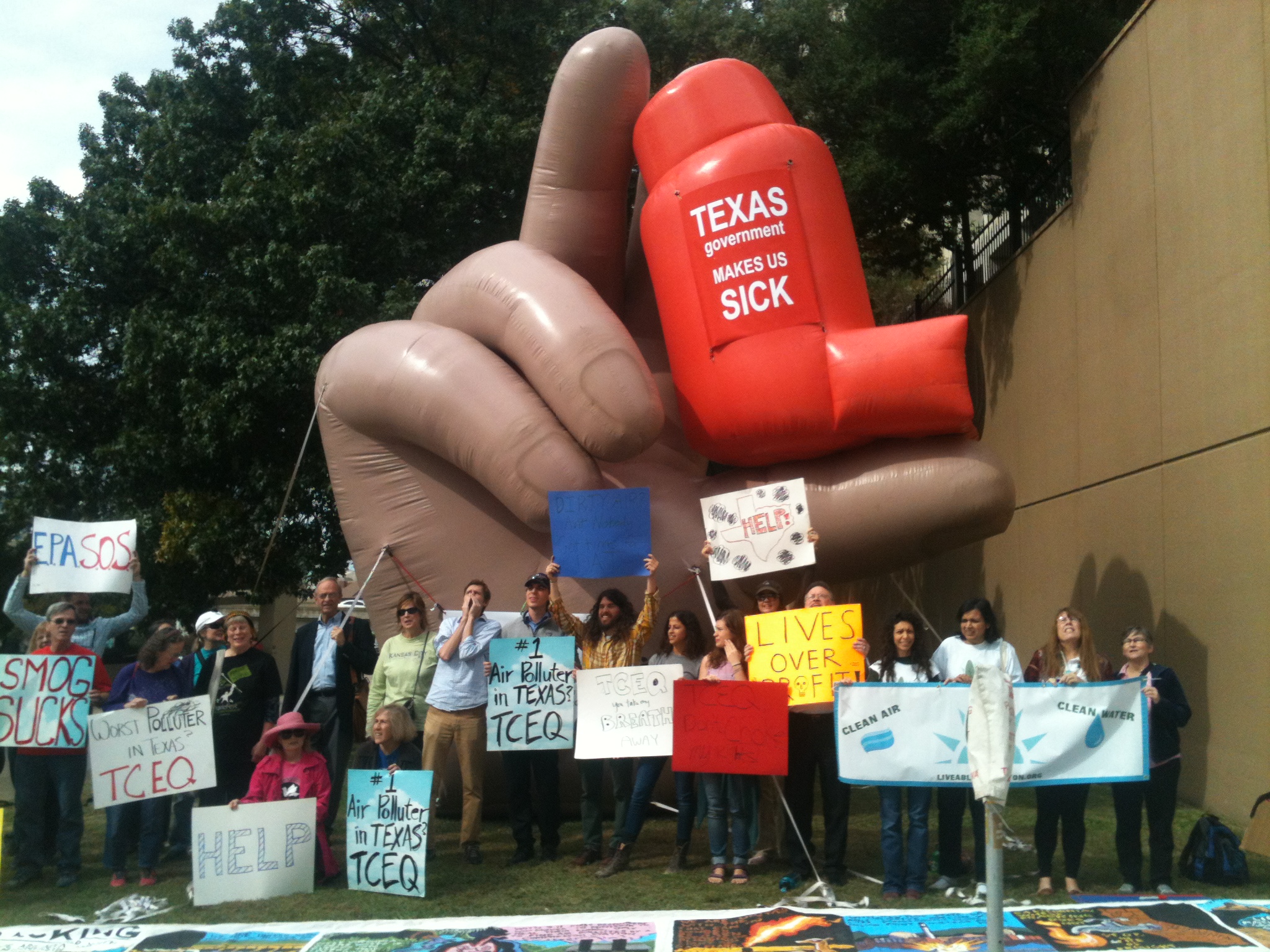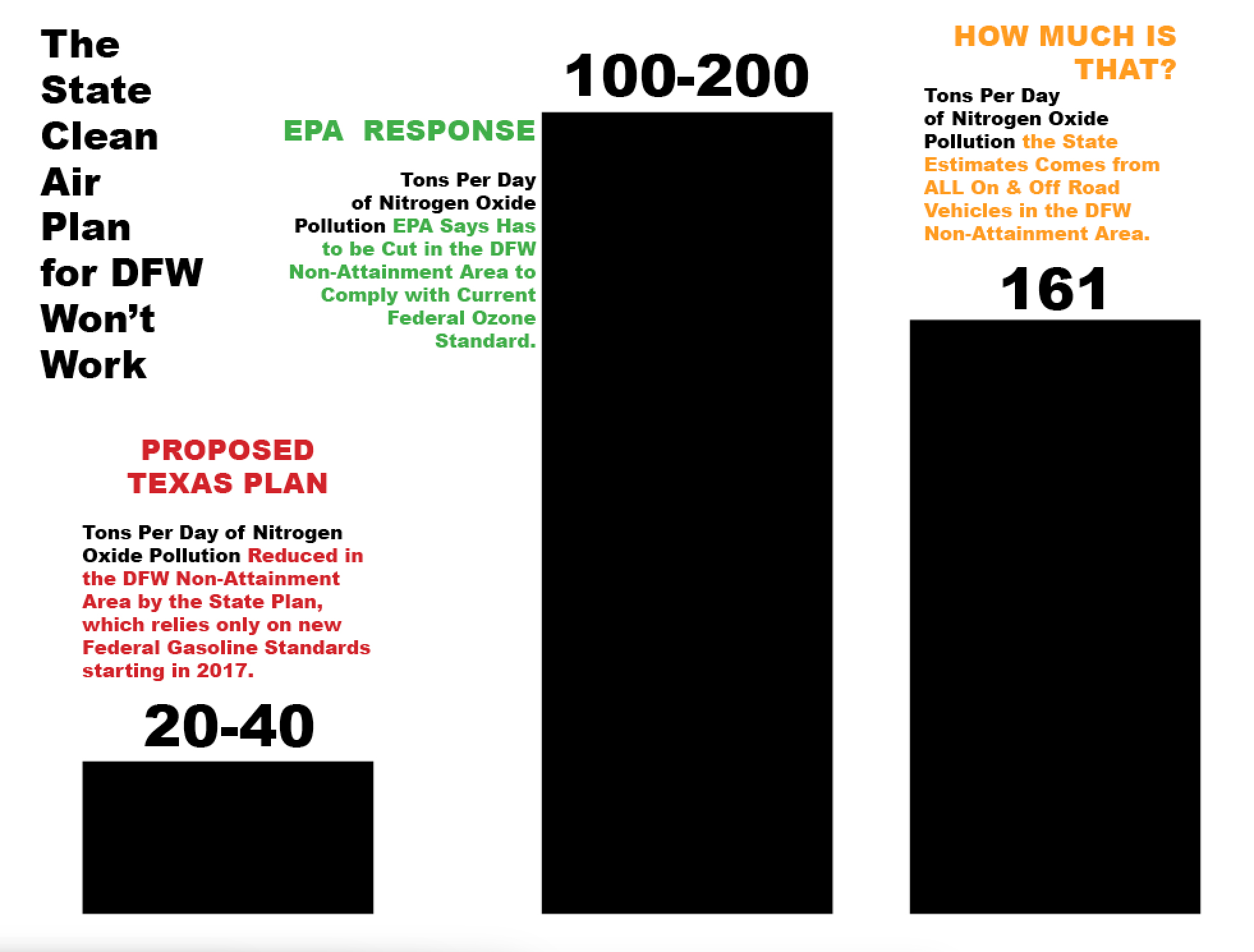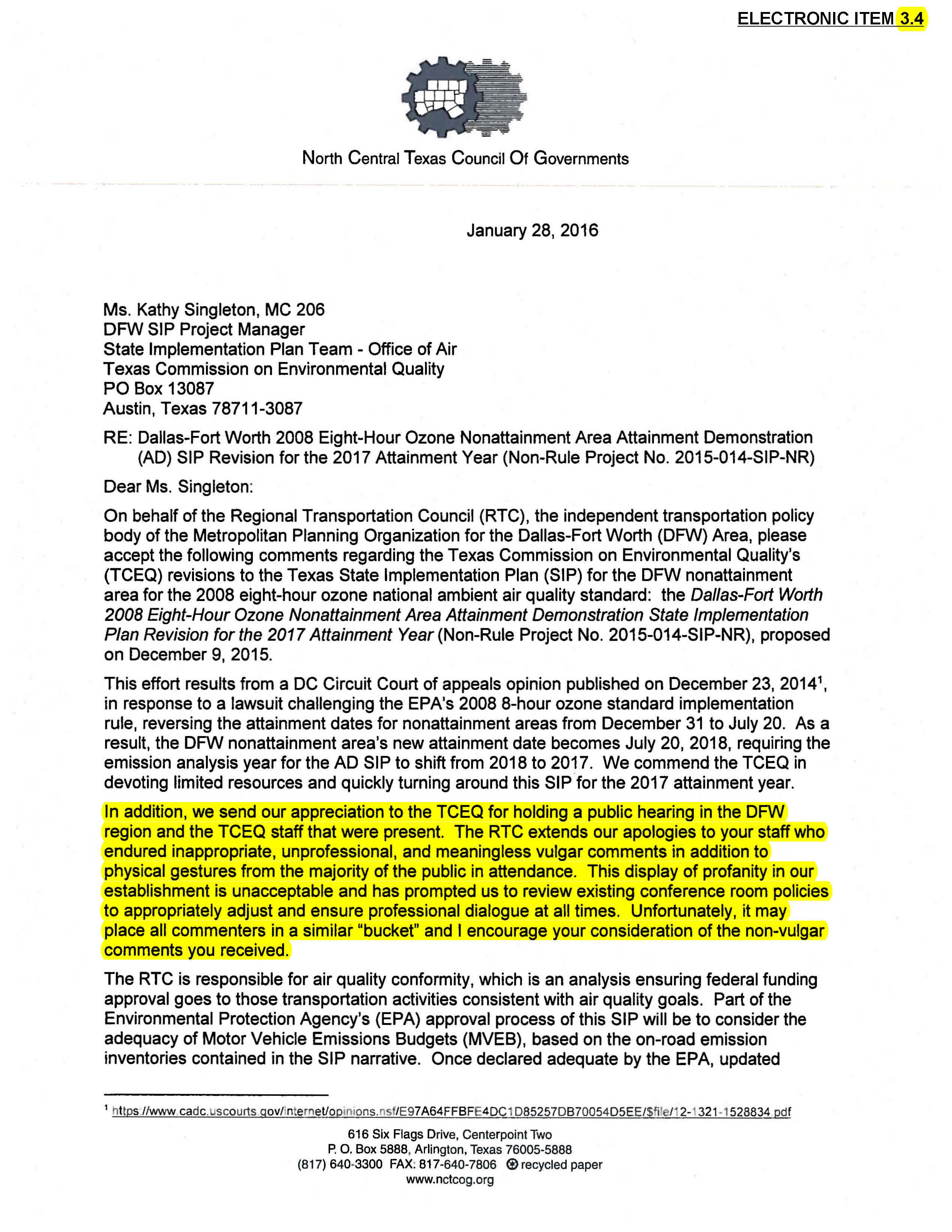Posts by jim
Our Drone Will Go Where the Empire, er, TCEQ Won’t
 In yet another shift away from the state's monopoly on air quality information, breathers in North Texas won't have to rely on the Austin-designed system of local air monitoring much longer.
In yet another shift away from the state's monopoly on air quality information, breathers in North Texas won't have to rely on the Austin-designed system of local air monitoring much longer.
On Sunday, Downwinders at Risk won its category in the Earth Tank competition at Earth Day Texas and brought home $3000 to buy a drone the group will modify to perform its own air DFW sampling and monitoring operations.
Working with the TCU engineering department, Downwinders will use the money to purchase a heavy-duty consumer drone and outfit it with small air pollution sensors and sampling equipment that work in concert with smart phones and laptops. The result will be an instrument able to give citizens and scientists real time information about air pollution.
As far as we know, we'll be the first group in the state to have this kind of capability.
Our presentation on Sunday made the case that the current DFW air monitoring network run by the Texas Commission on Environmental Quality gives an incomplete picture of air pollution threats in DFW. Both the limited number of air monitors and their immobility were cited as faults that could be depriving residents of a fuller, more accurate picture of DFW's chronic air pollution problems. Our answer was an air sampling drone that could go practically anywhere at anytime and sample for many different pollutants depending on what's being monitored.
One of the examples we used was Wise County, which is the most recent addition to the DFW 'non-attainment area" for smog. Despite it now being a part of the regulated smog zone, and despite the fact repeated computer air modeling by the state shows the highest smog levels in the region could be found there, Wise County has no smog monitors. Not a one.
Austin knows if it puts a new monitor is Wise County, DFW's annual smog average might go up even higher than it is now, and so the TCEQ has treated the County like it's not there.
Downwinders' drone will be able to show-up in Wise County on "ozone action days" and actually take real time measurements of smog for evidence demonstrating the need for an official monitor. TCEQ already hates this idea.
We'll also be able to do things like take methane readings over the gas patch, montior the plumes at accident sites (think the Magnablend catastrophe in Waxahachie a few years ago), and carry out experiments and research projects for area scientists – all the things TCEQ should be doing, but isn't.
This new tool allows us to enter into colaborations with other groups, local governments, and university programs. It's a teaching device we can take to schools. It can back-up citizen complaints. The uses are many.
But as we told the panel of judges on Sunday, our real "killer app" is not the drone itself, but the organization of people we put in place to operate it and decide how to use it.
Dr. Michael Slattery of the TCU Institute of Environmental Studies will head a group of researchers, technicians, and citizens who will assess projects, train drone pilots, and help administer "The North Texas Clean Air Force." Downwinders at Risk board member and Mansfield fracking activist Tamera Bounds has already signed-up. "I can't wait to learn how to fly that thing."
With the creation of this group, we'll be establishing a parrallel air quality monitoring program that once again opens up a previoulsy closed black box in Austin to citizen use. Just last November, we unveiled our DFW Ozone Study that, for the first time ever, took the state's own computer air model for DFW, cloned it, and had it do things the state did not want done – like tell us how much less smog would be breathed in DFW if you put modern controls on the largest industrial polluters.
In taking on these responsibilities which have tradtionally fallen to the state, our goal is not only to provide valuable new tools to citizens, but build new structures of decision-making about air quality that puts citizens in charge. For us, it's as important to change the way we make decisions as it is to add to the scientific literature, or bring smog levels down. It's right there in our mission statement,
Our goal is to build a strong grassroots constituency and create new strategies for clean air in North Texas.
We do this by informing, connecting and mobilizing citizens to become active participants in the decision-making that affects the air we breathe.
In doing so, we improve both the quality of our air and the quality of our democracy.”
We still have a lot of research to do, a lot of mistakes to make, a lot of experience to absorb, but creation and operation of a North Texas Clean AIr Force is one more step to building the kind of citizens' self-defense system necessary when your state government abdicates its job of public health protector.
Now, because the state's monopoly on data is crumbling with each new advancement in micro-processing, we're willing and able to step into this vacuum of leadership. Our goal is not only taking over the jobs Austin isn't doing, but creating a more citizen-friendly way of doing those jobs.
Move over TCEQ, the North Texas Clean Air Force is about to take off.
Federal and Local Officials Send Own SOS To EPA to Reject Do-Nothing DFW Anti-Smog Plan
Release from Dallas County Commissioner Theresa Daniel's office today at 3:30 pm
Officials Seek EPA Help in
Clean-Up of DFW Smog
Rep. Johnson and Veasey send letter to Agency chief;
Commissioner Daniel puts resolution on May 3rd
Dallas County Court agenda, say “more
progress needed” than current
state air plan delivers.
(Dallas)— In an unprecedented coordination of local and congressional action on air quality, elected officials announced they were formally asking for the EPA’s help in producing a better plan to clean up DFW’s chronic smog, now in its third decade of violating the Clean Air Act.
In Washington, Dallas Representatives Eddie Bernice Johnson and Marc Veasey released the contents of an April 19th letter they sent EPA Administrator Gina McCarthy, citing the Agency’s own public comments, and calling the state's current plan for addressing air quality in DFW ‘insufficient to meet the existing federal ozone standard.”
“We ask you to consider rejecting the state’s plan and the use of a Federal Implementation Plan if your agency decides that the final SIP revision is insufficient.”
In Dallas, County Commissioner Theresa Daniel has put a resolution on the Court’s May 3rd agenda that urges the EPA “to reject the proposed State Implementation Plan for DFW ozone pollution, and require a new federal DFW clean air plan that can meet or exceed the current 75 ppb federal ozone standard…"
Daniel’s resolution also requests the EPA to “regulate East Texas coal plants as if they were in the DFW non-attainment area, or include them in a larger non-attainment area for North Texas under rules governing the new federal 70 ppb ozone standard.”
“What’s at stake is the last opportunity to take a coordinated regional approach to reducing air pollution until at least 2021,” said Daniel, who’s been helping oversee a local air quality research project produced by the UNT Engineering Department. “After decades of being in violation of the Clean Air Act, we need more and faster progress to solve this serious public health issue costing us lives and dollars every year”
What Daniel and the Representatives are seeking is an official EPA rejection of an anti-smog plan for DFW and surrounding counties already passed by the state and on its way to EPA. The plan provides for no cuts in pollution from any major sources in North Texas, relying instead on a coming 2017 nationwide federal mandate that will reduce smog-forming pollution from traffic.
Because its contents are well known and a public comment period has passed, EPA’s skepticism of the state’s plan is on the record. The Agency’s conclusion that the plan needs some 100-200 tons a day more in additional air pollution cuts to attain the necessary drop in smog is used in the congressional letter calling for federal intervention. Daniel’s resolution also cites the EPA’s comments as one of the reasons the region needs to reject the state plan and draft a better one.
Although unprecedented in the long history of DFW air quality planning, the officials’ request follows on the heels of a similar resolution passed by the Texas Medical Association last year., spurred on by local Dallas County doctors who’ve been speaking out about the health dangers of DFW’s continuing smog problem. Many of those same doctors say they’ll be present on the 3rd to voice their support for Daniel’s resolution and praise Johnson and Veasey for taking the lead in Washington.
“Evidence is overwhelming that our high ozone levels are causing increasing numbers of area children to develop asthma, and are contributing to the many asthma attacks, chronic lung disease exacerbations, and heart attacks we see every day in our emergency rooms, clinics and hospitals,” said Robert Haley, MD, a Dallas internist and epidemiologist. “A large body of medical research shows that more people of all ages develop respiratory illnesses and die prematurely in cities with high ozone levels, and we have among the highest ozone levels in the country.”
On Wednesday the American Lung Association issued its annual “State of the Air” report and once again gave the Dallas-Fort Worth area an “F” for air quality. Although the number of dirty air days and their severity has fallen over the years, the region is still not in compliance with the Clean Air Act.
Daniel cited the new report as one more reason she, Johnson, and Veasey have to take action now. “This is the only opportunity until the next decade to get a better clean air plan for North Texas. If we don’t take the right steps in 2016, we’ll still be getting an “F” in 2026.”
__________________________________________________________________________________
Downwinders’ Drone Air Monitoring Project Makes Finals of “Earth Tank Prize” Competition
 In what would be a huge leap forward in the ability of citizens to do their own air monitoring, Downwinders' proposal to purchase a drone and use it for regional air quality sampling is in the running for Earth Day Texas' "Earth Tank Prize" competition.
In what would be a huge leap forward in the ability of citizens to do their own air monitoring, Downwinders' proposal to purchase a drone and use it for regional air quality sampling is in the running for Earth Day Texas' "Earth Tank Prize" competition.
Purchasing the first aircraft in a new citizen-organized "North Texas Clean Air Force" is now one of nine projects to be pitched live in front of a "Shark Tank"- like atmosphere of audience and judges on the last day of the Fair Park extravaganza. Locally-based Downwinders' is in direct competition with two other groups in the category of organizations with budgets under $100,000 annually: statewide group Texas Campaign for the Environment, and Austin-based Rainforest Partnership. The prize is a $3000 grant.
Earth Tank Prize 2016 is an initiative of Earth Day Texas (EDTx) and Dallas Festival of Ideas (DFOI) that awards cash prizes to environmental non-profit groups for important conservation and sustainability projects in Texas. The other two categories of contestants – non-profits making between $100-500,000, and those bringing in over $500,000 also have three finalists each and are competing for prize packages of $7,000 and $15,000 respectively. The complete list of finalists is here.
For our own effort, Downwinders has partnered with Dr. Michael Slattery of TCU's Institute for Environmental Studies, who has experience in both air quality modeling and using drones for conservation of rhino populations in Africa. Dr. Slattery would head a committee determining the use of the drone to insure scientific credibility and useful, robust data. Local academic institutions and non-profits would be able to propose projects that would be weighed on their ability to add to public policy and public health.
Besides its capacity to provide a new tool for researchers, the Downwinders' drone could also become an important enforcement tool for citizens.
Having the ability to monitor and sample air quality in real time anywhere in the North Texas area is a game changer for local public health policy. Not only can a wide variety of hypotheses be tested relating to plume transport and content, but you’d have the ability to monitor downwind of catastrophic accidents, and confirm the compliance of major polluters. You can show where the state should place new official monitors, and what pollutants those monitors should be targeting. You can map more effective control strategies using the results.
As we noted in our submission, what’s unique about this proposal is not that it employs a drone, but that it’s a direct assumption of government responsibilities by local citizens and experts. Much like Downwinders' recent taking over of the state's air computer modeling duties for smog, churning out a map for cleaner air the state could not bring itself to produce, this is a way that citizens can not just supplement, or replace the state's current air monitoring and sampling program. We can build a better one.
All nine finalists for the Earth Tank Prize will pitch live to an audience and judges at Fair Park Sunday, April 24th. We'll follow-up with details as to when and where. Cross your fingers.
New Study: Premature Births Caused by Dirty Air Cost the US $4 billion a Year
 There are no shortages of studies linking bad air with birth defects and premature births. But until now no one has taken on the task of trying to add up the national toll in both lives and money.
There are no shortages of studies linking bad air with birth defects and premature births. But until now no one has taken on the task of trying to add up the national toll in both lives and money.
In a study published in Environmental Health Perspectives on Tuesday, UCLA researchers estimated that almost 16,000 premature births across the country in 2010 — about 3 percent of the nationwide total of 475,368 — were related to exposure to high levels of "air polution" – in this case the insideous and ubiquitos Particulate Matter, or PM. These premie births cost the system $4.33 billion, including $760 million spent on prolonged hospital stays and long-term use of medications, as well as $3.57 billion in lost economic productivity due to physical and mental disabilities associated with preterm birth.
"For policy makers, decisions about regulating air pollution come down to a trade off between the cost of preventing air pollution and the health and economic benefits of limiting air pollution sources," study author Dr. Leonardo Trasande, associate professor in the Departments of Pediatrics, Population Health and Environmental Medicine at NYU Langone Medical Center. "Without data documenting the health effects of air pollution on preterm births, there's only one side to that discussion. So what we did was to quantify the disease burden and economic cost associated with preterm birth that could be traced to air pollution."
Developing fetuses are very vulnerable to pollutants of all kinds. That's why doctors tell women not to smoke during pregnancy. Exposures to high levels of air pollution increases toxic chemicals in the blood and can weaken the immune system, causing stress to the placenta and leading to preterm birth (defined as birth before 37 weeks of pregnancy)
PM pollution represents a threat because the particles are so tiny and fine they pass from your lung right into your blood stream and go where ever the flow takes them – to your heart, your liver, your brain. PM can also act as a kind of toxic suitcase for whatever other polutants came out of the same smokestack or exhaust pipe – metals, endocrine disruptors, etc.
Premature babies face greater risk of health issues including heart and breathing problems, weaker immune systems, anemia, jaundice and other complications. Longterm, while many preemies grow up healthy, they can be more likely face hearing or vision problems or developmental disabilities.
The study authors emphasized that this burden is preventable and say they plan to share their findings with policymakers in an effort to help shape regulations and laws designed to reduce air pollution.
"This really speaks to the need to continue with efforts to reduce air pollution from coal-fired power plants and vehicle exhaust," Trasande said. We have some of those in Texas.
Monthly TEDX Teleconference Tutorial on the Hazards of Fracking
 Founded by the late great Theo Colburn, who along with her co-authors of "Our Stolen Future" way back in 1996 just about invented the field of "endocrine-disrupting chemicals," the Endocrine Disruption Exchange (TEDX) is holding a monthly teleconference series begining in April focusing on chemicals associated with fracking.
Founded by the late great Theo Colburn, who along with her co-authors of "Our Stolen Future" way back in 1996 just about invented the field of "endocrine-disrupting chemicals," the Endocrine Disruption Exchange (TEDX) is holding a monthly teleconference series begining in April focusing on chemicals associated with fracking.
First up on Thursday, April 7th at 1 pm is Dr. Chris Kassotis, who's been looking at the connection between fracking chemicals and surface and ground water contamination near fracking sites. According to the TEDX release, Kassotis will speak about…
"…his recently published research demonstrating increased endocrine disrupting activity in surface and ground water near fracking wastewater spill sites, as well as nuclear receptor antagonism for 23 commonly used fracking chemicals. His studies have shown prenatal exposure to a mixture of those chemicals at likely environmentally relevant concentrations resulted in adverse health effects in both male and female C57 mice, including decreased sperm counts, modulated hormone levels, increased body weights, and more. Dr. Kassotis will also discuss his recent work showing increased receptor antagonism downstream from a wastewater injection disposal site.
Dr. Kassotis is a Postdoctoral Research Associate in the Nicholas School of the Environment at Duke University. He completed his PhD at the University of Missouri working with Susan Nagel to assess unconventional oil and gas operations as a novel source of endocrine disrupting chemicals in water, and the potential for adverse human and animal health outcomes from exposure.
This April get together is one of three briefings being given from now until June. According to a preview of the next two calls:
Thursday May 5, 2016, 1:00 pm Central – Dr. Shaina Stacy will discuss "Perinatal outcomes and unconventional natural gas development in Southwest Pennsylvania"
Thursday June 2, 2016, 1:00 pm Central – Dr. Nicole Deziel will discuss "A systematic evaluation of chemicals in hydraulic-fracturing fluids and wastewater for reproductive and developmental toxicity"
You have to go online and register as a participant if you want to listen in or ask quesitons via a live chat line.
Bring the East Texas Coal Plants into DFW’s Smog “Non-Attainment Area” and See How Long They Last……
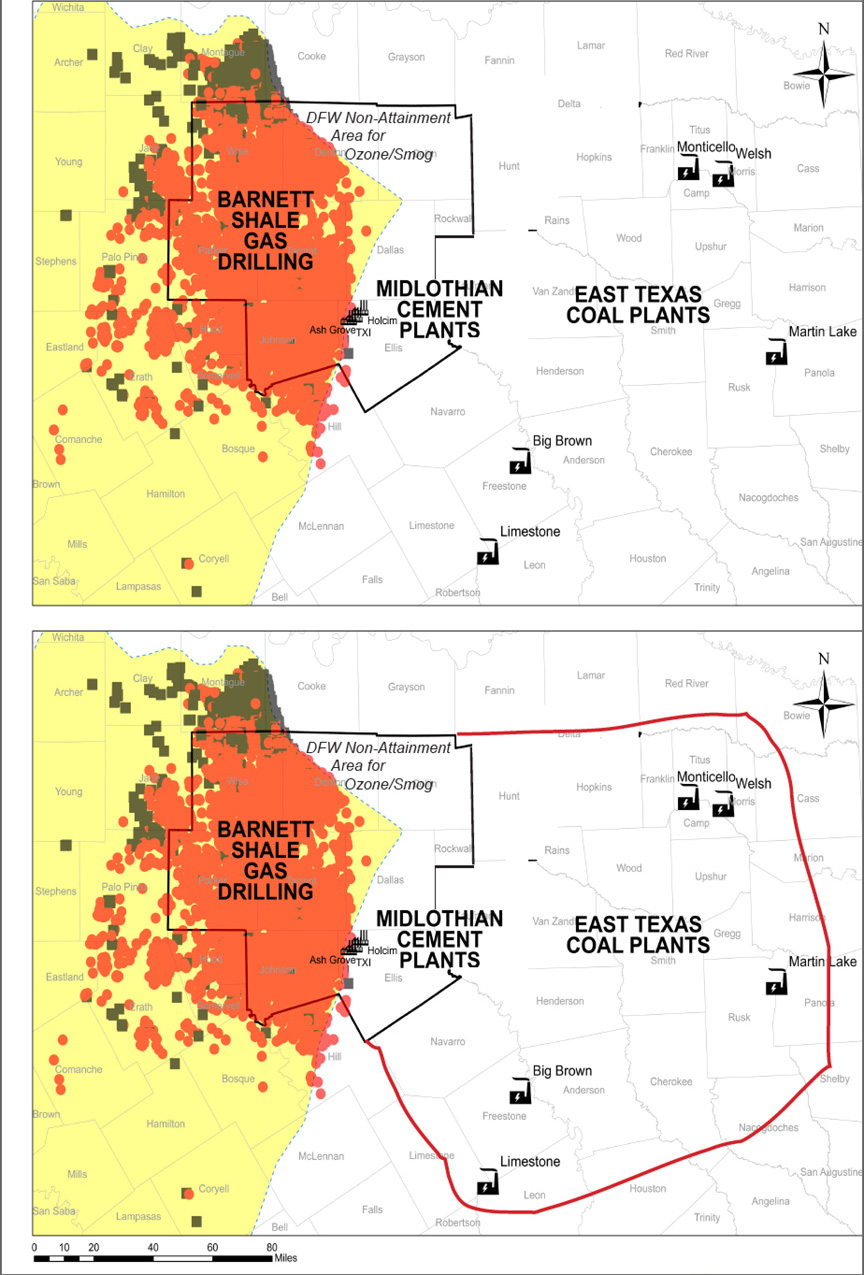 Want the Coal Plants to Face the Kind of Regulation
Want the Coal Plants to Face the Kind of Regulation
They've Been Avoiding for Decades?
Click here and send a formal comment letter demanding the coal plants
be included in the new DFW non-attainment area for smog.
Even as we're all waiting to see what EPA decides to do about the current Texas air plan for DFW under the current 75 ppb ozone standard, the regulatory process is gearing-up to administer the new 70 ppb standard.
One of the things which must be decided by the EPA are what geographical boundaries to use for the new standard when it comes to the DFW airshed and its chronic smog condition. Should they stick with the current 10-County configuration or should it be different and/or more inclusive?
The history of DFW's smog fight is a lengthy chronicle of bringing new counties into the fold despite official resistance. Originally, the DFW non-attainment area was only Tarrant, Dallas, Collin and Denton. Then Rockwall, Parker, and Johnson Counties came in because of their commuter traffic.
Downwinders had to petition the EPA to bring Ellis County and its cement industrial complex into the non-attainment area early in this century after being told repeatedly by state officials that its pollution had no impact on DFW air quality.
More recently, the state argued against the inclusion of Wise County, despite its huge inventory of oil and gas pollution, population of commuters, and more than likely, the highest ozone levels of anywhere in North Texas. EPA decided to bring it in anyway.
We're once again at a crossroads, and it could be the most significant one in a decade.
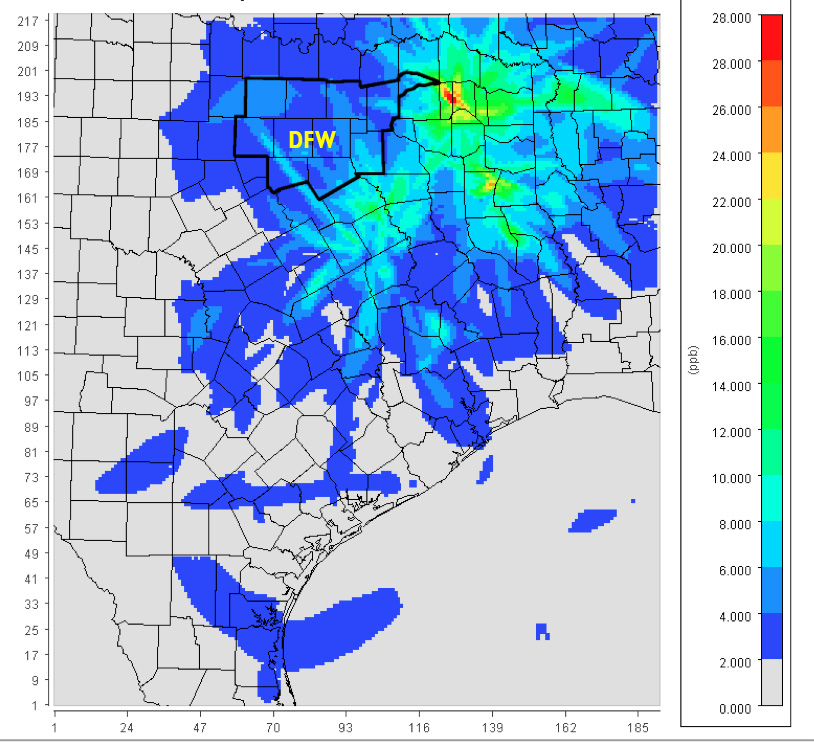 New evidence shows the huge impact the East Texas coal plants have on DFW air quality. Every scenario run by the UNT Engineering Department with the state's own DFW air computer model as part of Downwinder's Ozone Attainment Project demonstrates there's no more effective smog fighting strategy than reducing or eliminating the pollution from these coal plants.
New evidence shows the huge impact the East Texas coal plants have on DFW air quality. Every scenario run by the UNT Engineering Department with the state's own DFW air computer model as part of Downwinder's Ozone Attainment Project demonstrates there's no more effective smog fighting strategy than reducing or eliminating the pollution from these coal plants.
In fact, with a few other measures within the DFW area itself, controlling or eliminating their emissions could bring us in compliance with the 75 ppb standard, something that's not likely to happen otherwise.
Why is it so important to officially bring them into the DFW non-attainment area? Because major sources of pollution like coal plants are regulated differently inside than they are outside the area.
Right now, many DFW businesses are having to pay to operate and maintain pollution control equipment although most emit a tiny fraction of the pollution coming from the coal plants. That's because they're located in one of the ten counties in the DFW non-attainment area. They're held to a higher standard of control than their peers doing business outside those ten counties.
On the other hand, despite their large contribution to DFW's chronic ozone problem, the East Texas coal plants remain untouched by the same regulations and are not held to that higher standard. What sense does that make?
As much sense as it made to keep the cement plants out. As much sense as it made to try and exclude Wise County.
As per usual, the EPA is letting the state have first crack at defining a new DFW smog zone. The state has decided to leave the boundaries the way they are.
 Now, it's your turn to comment on that state decision, and tell Austin and the EPA – which will review the State's recommendations – what you think needs to happen.
Now, it's your turn to comment on that state decision, and tell Austin and the EPA – which will review the State's recommendations – what you think needs to happen.
The state is accepting comments on its decision until April 15th. This time, you can send your comments directly by e-mail instead of having to go through the official Texas Commission on Environmental Quality website
If you want to use our ready-to-send letter, all you have to do is CLICK HERE , sign the letter and add your own comments if you want. Then one more click and it's on it's way to Austin.
If you want to write your own comments:
EMAIL: kristin.patton@tceq.texas.gov
SNAIL MAIL: Kristin Patton, MC 206, State Implementation Plan Team, Office of Air, Texas Commission on Environmental Quality, P.O. Box 13087, Austin, Texas 78711-3087,
FAXED:(512) 239-6188.
All comments should reference "2015 Ozone NAAQS Designation Recommendations."
Lois Gibbs Is Offering You Money
 Many of you got a chance to meet and hang out with American grassroots legend Lois Gibbs during our Root and Branch Review last November. Now comes news that her Virginia-based Center for Environmental Health and Environmental Justice is opening up a new round of small grants for local groups.
Many of you got a chance to meet and hang out with American grassroots legend Lois Gibbs during our Root and Branch Review last November. Now comes news that her Virginia-based Center for Environmental Health and Environmental Justice is opening up a new round of small grants for local groups.
According to the Center's release, "grassroots communities of color, low wealth, faith based, rural and urban groups are encouraged to apply. This grant program will support projects that help groups move towards their goals by building leadership and/or the group’s capacity. These projects could include meetings to develop an organizing strategy plan, training events, educational activities or membership outreach. The grant awards will be uwith annual budgets of no more than $50,000.
CHEJ’s Small Grants Program helps grassroots, community organizing groups build their capacity. The program is designed to especially reach people from low wealth communities and communities of color who are impacted by environmental harms. Grant activities can include board development, membership outreach, and fundraising efforts. Project activities could also include meetings to develop an organizing strategic plan, training events, educational activities which are directly connected to your strategic plan, or membership recruitment. It is recommended that project activities be creative, effective and/or strategic."
Not an official 501c3 non-profit? Not a problem if you can find a friendly one to piggyback on as "a fiscal sponsor" to accpet the funds on your behalf.
Deadline for proposals is Friday, April 8th. The short two-page application can be downloaded here: Small Grants Outreach Letter Application 2. Any questions can be directed at the group via their email address, info@chej.org.
Good luck.
A Guide to the State’s War on the Clean Air Act
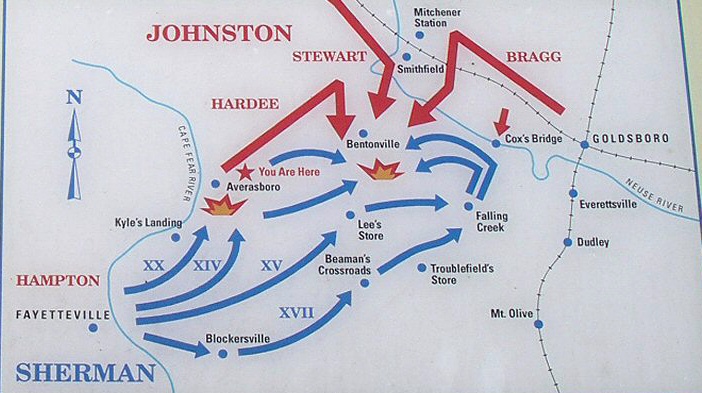 There's been a lot of activity lately on the many-fronted war the State of Texas is conducting against the Clean Air Act. What about a brief status report:
There's been a lot of activity lately on the many-fronted war the State of Texas is conducting against the Clean Air Act. What about a brief status report:
1) Mercury Rules
Thursday's headline was that Supreme Court Justice Roberts denied the attempt by Texas and 18 other states to delay the implementation of EPA's new, more protective limits on release of toxic Mercury pollution from coal plants. In 2013, three out of the top five largest Mercury polluters in the whole country were Texas coal plants.
It was only last summer that majority of the entire Court ruled EPA hadn't followed protocol in weighing costs to the coal industry versus public health benefits, and sent the standard back to the Agency to be rewritten. Not an especially big deal.
Texas, along with other states, sought an injunction from Justice Roberts to stop the timeline for implementation of the rules until the rewrite was finished. Roberts denied the request and so EPA is allowed to continue writing the rules and now expects to release the revised edition next month. One indication of how much trouble the rules are in, or not, is the speed and format of Robert's actions. He ruled on the case only a day after the EPA had submitted its brief, and ruled on it unilaterally, not bothering to convene the full Court.
The practical implications of the rules are reductions in the use of coal with higher Mercury content, better Particulate Matter pollution control equipment, and specific carbon absorption control technology aimed at Mercury. Many Texas coal plants have already taken steps to comply with the standards and it seems like almost all have applied for extensions to the original deadline.
2) Haze Rules
Earlier this week, Texas Attorney General Ken Paxton announced the state was suing the EPA for rejecting its lackadaisical plan to protect national parks from haze air pollution, also mostly coming from coal plants. Just three Luminant coal plants – Big Brown, Martin Lake and Monticello – release 40% of all Texas’ Sulfur Dioxide air pollution.
Late last year, EPA announced it found the state's lightning-fast 140-year plan to do absolutely nothing somehow inadequate, and begin to draft one of its own that would require "scrubbers" for Sulfur Dioxide pollution at nine coal plants across the state. It also concluded Texas had intentionally downplayed the impact of the coal plants on park air quality in computer modeling submitted to EPA .
Texas is suing to prevent the EPA from enforcing its plan to require scrubbers and asking the court to accept the original Texas plan as reasonable. Pending.
3) Sulfur Dioxide Non-attainment Areas in East Texas
In mid-February, EPA announced it intended to declare areas surrounding three East Texas coal plants as out of compliance with national Sulfur Dioxide pollution limits and declared them in official "non-attainment" of the Clean Air Act. Big Brown, Monticello, and Martin Lake power plants were found to be causing the violations in ambient air quality using computer modeling results first run by the Sierra Club, and then analyzed by the EPA. Boundaries were drawn for the new non-attainment areas that include all or parts of Freestone, Anderson, Rusk, Gregg, Panola, and Titus counties.
Final action by EPA on the non-attainment area classification is scheduled for this summer. Then it will be up to the state to submit a plan for action. We can all write the script from there. It ends in a court ruling.
Eventually, these East Texas non-attainment areas are another tool by EPA's to raise the costs of operating the oldest, most polluting coal plants to better reflect their toll on public health. Plants could lower their Sulfur Dioxide emissions by importing more "Cleaner Coal" from Wyoming and/or paying for those scrubbers the Haze Rules requires too.
4) DFW Clean Air Plan
DFW is in "non-attainment" for ozone, or smog pollution. It has been since 1991. The State has submitted a plan to EPA that sits back and watches federal fuel changes reduce smog-forming pollution by 20-40 tons per day. The problem? EPA estimates it will take cuts of 100-200 tons per day to get down to the current ozone standard of 75 parts per billion. The state says it sees no reason for more cuts.
This is the state plan up for comment at the the now infamous "F*** the TCEQ" public hearing in Arlington in late January, with final submission to EPA by the state this summer.
But between now and then one of the headlines you should see will be EPA rejecting the part of the state's plan dealing with pollution control technology. EPA has already telegraphed their intention to do so, and they don't have to wait for the state's final submittal deadline to act.
This will, of course, be followed by the state's suing the EPA for daring to enforce the Clean Air Act when Austin won't. But it won't keep the EPA from doing exactly what it did in the Haze Rule fight – write its own clean air plan for DFW.
And that will be our chance to make the greatest leap forward in local air quality in a decade.
How to Outflank HB40 in the Barnett Shale
 Last week, the EPA made an important admission.
Last week, the EPA made an important admission.
"Methane emissions from the oil and gas industry are significantly higher than previous official estimates, according to draft revisions of the U.S. greenhouse gas emissions inventory released Monday by the Environmental Protection Agency. At 9.3 million metric tons, revised estimates of 2013 emissions are 27% percent higher than the previous tally. Over a 20-year timeframe, those emissions have the same climate impact as over 200 coal-fired power plants."
This most recent analysis jives with other studies like the one from UTA/EDF that found Barnett Shale facilities leaking up to 50% more methane than previously estimated. In reaction to the information, EPA Chief Administrator Gina McCarthy was quoted as saying "we need to do more" to cut methane pollution.
In its last year in office the Obama administration is finally grasping that natural gas isn't the climate change wunderkind its promoters claimed and last week's announcement is the tacit admission they need to do more to crack down on oil and gas.
What has that got to do with DFW in 2016?
By Spring, the Regional office of the EPA is expected to announce that it has rejected the State's clean air plan for DFW in regard to its application of "Reasonably Available Control Technology." That means the state hasn't required the application of readily-available air pollution controls for major sources the way the Clean Air Act demands. Specifically, EPA staff have cited the failure of the state to lower the emission standards for the Midlothian cement kilns to reflect more modern technology. But it's not the only area where Texas fell short. There are no new pollution requirements for any oil and gas facilities in the state's plan either.
EPA rejection of the Technology section of the state's DFW air plan would mean the EPA would begin to draft its own clean air plan for the region. An EPA-drafted plan gives local citizens concerned about the health impacts of fracking an opportunity to persuade the Agency to use the plan to crack down on smog-forming Nitrogen Oxide (NOx) and Volatile Organic Compounds (VOCs) pollution in the Barnett Shale by requiring lower emission standards on all aspects of drilling and production.
While methane isn't considered a smog pollutant, it doesn't get emitted by itself. It comes out of a stack or valve, or leaks from a pipeline combined with smog-forming VOCs. So the more you control VOC pollution, the more you control methane pollution.
In light of last week's announcement, this gives EPA an extra incentive to go after VOC emissions in DFW even though the conventional wisdom is that it's combustion-generated Nitrogen Oxide pollution that really makes DFW smog so bad.
BTW, that conventional wisdom is under attack because the worst-performing air monitoring sites in North Texas are all in the Barnett Shale and heavily influenced by pollution from oil and gas facilities – both NOX and VOCs. It's possible to imagine a strategy to get smog numbers down in DFW solely by application of oil and gas emission regulations that can impact these important monitors – which drive the entire region's fate – even if the new regs have minimal impact on monitors elsewhere.
What kind of new regulations are we talking about?
* Start with the electrification of all 650 large natural gas compressors in the 10-county area.
* Do the same thing for all drilling rigs in the same 10-county area – nothing but electric.
* Emission standards for tanks and pipelines that reflect the latest leak-detection technology.
Inclusion of new EPA “Control Technique Guidelines" which are part of Agency's new methane rules. According to the Agency's release on the the new rules, “…reduction of VOC emissions will be very beneficial in areas where ozone levels approach or exceed the National Ambient Air Quality Standards for ozone."
Under the new rules, areas like DFW that host large concentrations of gas pollution sources and are officially categorized as “non-attainment” for smog receive "an analysis of the available, cost-effective technologies for controlling VOC emissions from covered oil and gas sources."
There's one more reason EPA has an incentive to go looking for all the cuts in oil and gas pollution it can find in the 10-county DFW non-attainment area: after the cement kilns, there's no other major sources the Agency can target locally.
Because while it has the authority in a federal clean air plan to regulate all pollution sources in that 10-county DFW non-Attainment area, the EPA can't write new emission standards for the East Texas coal plants located 100 miles outside of that 10-county area – even though those coal plants have more of an impact on North Texas smog than any other source of pollution. EPA (and us) can put pressure on the state to address these dinosaurs, but it can't touch them through a DFW air plan.
EPA staff has estimated it will take a cut of 100-200 TONS PER DAY in local smog-forming Nitrogen Oxide pollution for DFW reach the current 75 parts per billion smog standard. The State's "plan" – i.e. the federal gasoline fuel changes it relies on – only represents a 20-40 tons per day cut.
Where do the other 60 -160 tons a day in cuts come from?
To give you some idea of the size of that gap, the state estimates that all on and off road vehicles in the 10-county area will emit 161 tons per day of NOx in 2018.
State-of-the-art controls on all the cement plants might give you up to 15 tons a day. Electrification of the large compressors, another 15-16 tons per day eventually. After that it gets hard to find large volumes of cuts without the coal plants. And this is why the EPA should give cuts in VOC/methane a longer look than they have before – they're concentrated in the same areas where the region's worst-performing monitors are and they represent a huge source of climate change pollution that could also be another skin on the wall in addition to lowering smog levels.
There's no question the passage of HB40 has stymied grassroots progress toward more protective regulation of fracking by municipal governments in the Barnett Shale. It's thrown what was a fairly successful local movement into disarray. To date, there doesn't appear to be any consensus about strategies to combat the effects of the legislation.
But a way to outflank some of the impacts of HB 40 coming is coming down the pike, and it offers local fracktivists an opportunity to rally round a common, achievable goal – lowering emission levels across the board in the Barnett Shale. We can overlay a larger, stricter regional template for oil and gas regulation in place of 100 separate municipal ones.
What better way to nullify the efforts of the nullifiers in Austin?
COG’s Michael Morris Criticizes “Vulgar” Comments from Citizens, But Not a Vulgar Air Plan from TCEQ
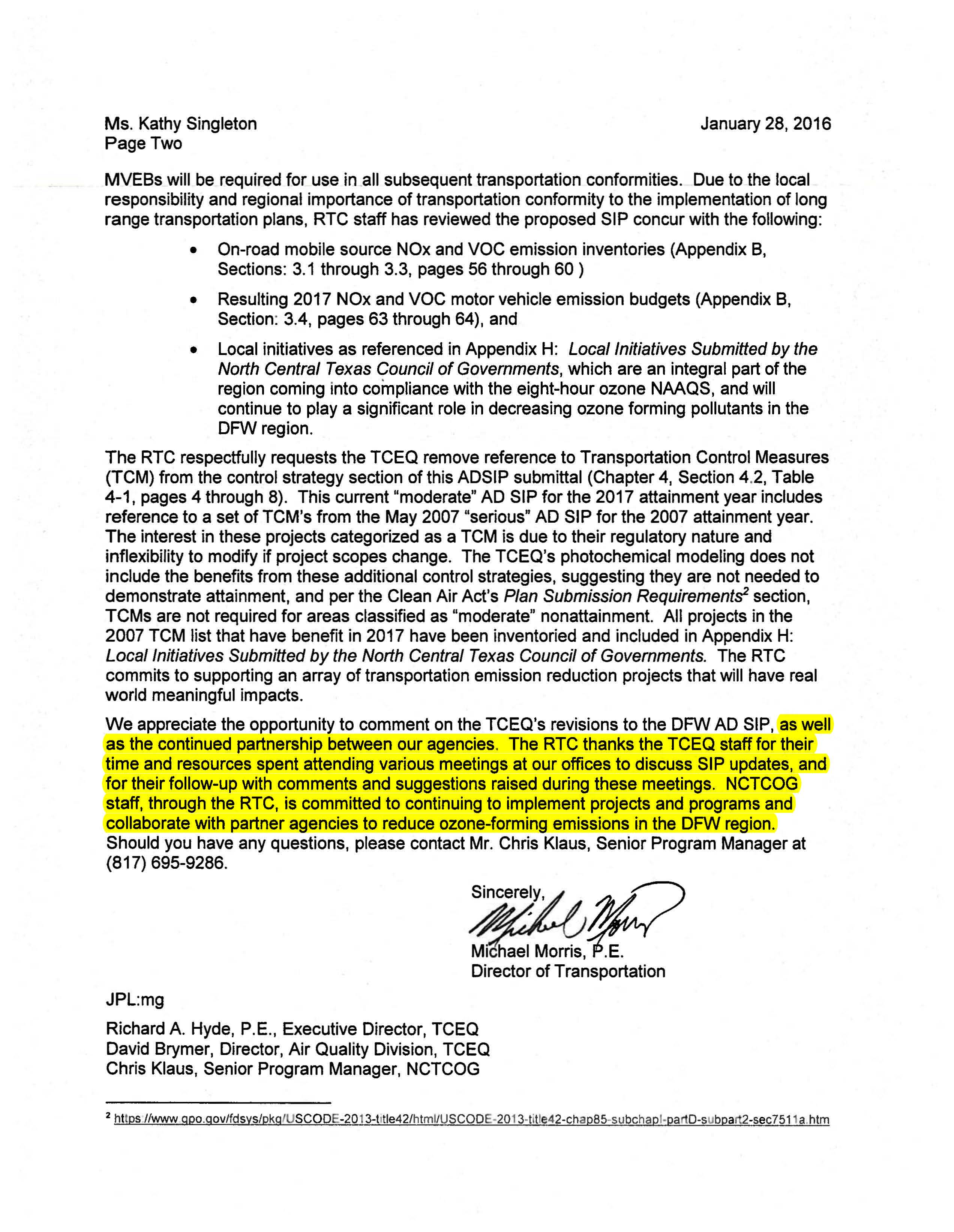 Don't look now, but Michael ("never met a freeway proposal I didn't like") Morris, the long-time Director of Transportation for the North Central Texas Council of Governments, has gotten a case of the Vapors.
Don't look now, but Michael ("never met a freeway proposal I didn't like") Morris, the long-time Director of Transportation for the North Central Texas Council of Governments, has gotten a case of the Vapors.
Was it some new threat to the Trinity Tollroad that sent Mr. Morris into a tizzy? Some "regional mobility" crisis?
No, nothing as small-minded as those examples.
Instead it's the "vulgar" language used by DFW residents in the state's public hearing on its new do-nothing air plan on January 21st that makes Mr Morris so darn mad he feels he has to apologize to the Texas Commission on Environmental Quality for it in a letter last month.
You see the hearing took place at NCTCOG headquarters in Arlington, in the COG conference room Mr. Morris uses to rule his freeway fiefdom from as the force behind the Regional Transportation Council.
We suspect that almost everyone official, including Mr. Morris, thought it would be another dreary affair when the conference room was offered up as a hearing space. But citizens had other ideas. After 20 years of failure, they weren't in any mood to accept another "plan" from the state that required no new pollution controls on any sources. They were mad as hell, and they weren't going to take it anymore.
No question more than one person uttered words and phrases you will not hear in Church. These were intentional and meant to shock everyone out of official complacency in another just-going-through-the-motions regulatory exercise. Commentators were following the advice of John Maynard Keynes: "Picturesque language, used right, serves an important purpose. Words ought to be a little wild, for they are the assaults of thoughts on the unthinking."
"Unthinking" is a generous way to describe the State's air plan.
Far from being "meaningless," as Morris' letter to the TCEQ asserts, the use of "bad words" at the hearing on the 21st was packed with decades of frustration. They meant something precisely because they had never been uttered before in such a place by people who had worked in good faith for so long on DFW's chronic smog problem. They meant something because citizens realize they no longer have anything to lose in calling out the State for its shamelessness. It meant something because the story that was told by employees the next day at TCEQ HQ in Austin and EPA HQ in Dallas was not the usual script for these things, but how badly the State got its ass kicked, and how genuinely angry the crowd was that nothing was being done about DFW bad air – again.
"Bad words" put an exclamation point on a problem. They can also unmask the Killing-Us-Softly language and protocol the TCEQ uses to make decisions that harm the public health. They pull back the curtain and give a more accurate, if less polite, perspective. If some citizens were dropping F-bombs toward the TCEQ at the hearing, they were only giving as good as they were getting.
Because make no mistake about it, in the way the State has drafted and approved this plan, it's making it's own bold declaration of F*** YOU to EPA and seven million DFW breathers.
By conservative estimates, the State's air plan for DFW needed to cut up to 200 tons per day or more of smog-forming pollution to get the the current ozone standard by the deadline of 2017. Instead the state is submitting a plan that gets only 20-40 tons per day of cuts – all from a change in federal gasoline rules. The EPA had already warned Texas in writing that the plan didn't include new, lower emission limits for the Midlothian cement kilns, and this exclusion would mean the plan was not meeting the Clean Air Act. The State submitted the same plan anyway.
But there was no criticism of this obscene gesture in Morris' letter. Instead he says he looks forward to working in continued partnership with the TCEQ – a partnership which has produced five (going on six) failed air plans and over twenty years of non-compliance with the Clean Air Act. Huzzah.
And that's why citizens were right to call out the TCEQ the way they did on the 21st. Here's an agency, COG, that's nominally, but officially assigned the role of local consultants on air planning for seven million DFW residents, and it's taking a complete whiff on the State's clear-eyed strategy of nullifying the Clean Air Act. If it can't even bring itself to mildly criticize the state for submitting a plan that's, you know, both unworkable and illegal, what other choice do citizens have but to scream bloody murder at the top of their lungs?
We're proud to have played a part in making DFW a hostile work environment for the political hacks who now run and staff the Texas Commission on Environmental Quality. They don't deserve to have an easy time of it. They should fear being run out on a rail or verbally tarred and feathered every time they make an appearance here. It's the only way citizens have to effectively show how they feel about a government that not only isn't listening, but has no interest in listening.
It's also activity protected by the First Amendment, a technicality that Morris seems like he's desperate to address for fear of his conference room being sullied by another severe outbreak of democracy.
And that's the thing about Morris' response. He's very concerned about the bad words. Not so much about the bad air.
You could put all the F-bombs dropped on the 21st on hundreds of billboards next to schools, and churches, and Mr. Morris' beloved freeways, where thousands would see and be offended by them. You could broadcast them over a loud speaker going through "nice" neighborhoods. You could open a website devoted to nothing but evangelizing their use or a cable channel that repeated them 24/7. You could assault people from every direction with bad words every waking minute of their day, and you'd still be doing less harm to the public than even one more month of dirty air courtesy of the state, and Mr. Morris's silence.
As for those citizens who were there on the 21st to give the start a hide tanning it deserved, maybe they were taking Jane Jacobs lesson to heart: "We had been ladies and gentlemen and only got pushed around."

